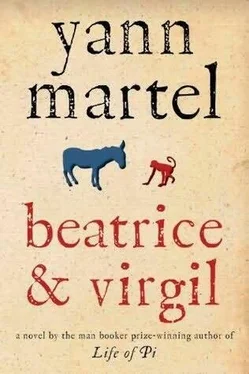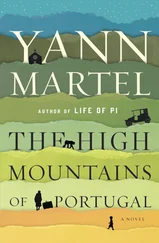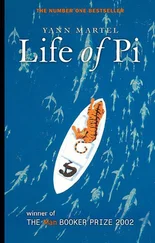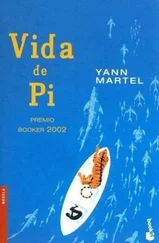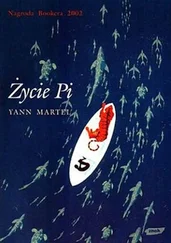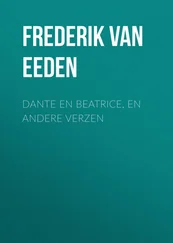Yann Martel - Beatrice and Virgil
Здесь есть возможность читать онлайн «Yann Martel - Beatrice and Virgil» весь текст электронной книги совершенно бесплатно (целиком полную версию без сокращений). В некоторых случаях можно слушать аудио, скачать через торрент в формате fb2 и присутствует краткое содержание. Жанр: Современная проза, на английском языке. Описание произведения, (предисловие) а так же отзывы посетителей доступны на портале библиотеки ЛибКат.
- Название:Beatrice and Virgil
- Автор:
- Жанр:
- Год:неизвестен
- ISBN:нет данных
- Рейтинг книги:5 / 5. Голосов: 1
-
Избранное:Добавить в избранное
- Отзывы:
-
Ваша оценка:
- 100
- 1
- 2
- 3
- 4
- 5
Beatrice and Virgil: краткое содержание, описание и аннотация
Предлагаем к чтению аннотацию, описание, краткое содержание или предисловие (зависит от того, что написал сам автор книги «Beatrice and Virgil»). Если вы не нашли необходимую информацию о книге — напишите в комментариях, мы постараемся отыскать её.
A famous author receives a mysterious letter from a man who is a struggling writer but also turns out to be a taxidermist, an eccentric and fascinating character who does not kill animals but preserves them as they lived, with skill and dedication – among them a howler monkey named Virgil and a donkey named Beatrice…
Beatrice and Virgil — читать онлайн бесплатно полную книгу (весь текст) целиком
Ниже представлен текст книги, разбитый по страницам. Система сохранения места последней прочитанной страницы, позволяет с удобством читать онлайн бесплатно книгу «Beatrice and Virgil», без необходимости каждый раз заново искать на чём Вы остановились. Поставьте закладку, и сможете в любой момент перейти на страницу, на которой закончили чтение.
Интервал:
Закладка:
A few days later, Henry wrote to Henry. Of his play he said:
… I found it well constructed and the characters interesting. The lightness was engaging and the pacing good, delivering an effective scene. You write a good pear. I especially liked the line "Those who carry a knife…" The names of the characters-Virgil and Beatrice-intrigued me. Bringing in Dante's Divine Comedy added an element of depth to my appreciation of what you've done. Congratulations. I wish you…
Henry wondered if his reader would see through the meaningless patter of the Dante comment. Of the Flaubert story, he wrote:
… must thank you for the Flaubert story. I had never read "The Legend of Saint Julian Hospitator". You're right that the hunting descriptions are particularly vivid. So much blood! What can it all mean?…
"Sarah, I'm going for a walk. Would you like to come?" Henry asked.
Sarah yawned and shook her head. By then she was healthily, but also sleepily pregnant. Henry put on his coat and set off with Erasmus. The day was brilliantly sunny but cold, hovering only a few degrees above the freezing point.
The walk proved to be longer than Henry had anticipated. He had not properly translated what his eyes saw on the map to the distance their feet would be travelling on the streets. They entered a neighbourhood he didn't know. He looked at the buildings, residential and commercial, noting their changing character, the history of the city and its inhabitants expressing itself architecturally. His lungs breathed in the cool air.
His destination led him to the bum end of an upscale commercial street that featured, among other smart businesses, a grand bridal store, a jeweller, a fancy restaurant and, at the end, on the right side, an attractive cafe with a large terrace. The terrace was bare of chairs and tables because of the weather, but looming over it on a brick wall, visible from the entrance of the street and promising warmth, was a mural of a cup of coffee with a steaming curl of fragrance wafting from it. At the level of the cafe, the street turned to the left and then, quickly, to the right. Past this second turn, there was another stretch of businesses on the left side of the street, and, on the right side, the high, windowless brick wall of a large building. A little farther along, the street turned again, to the right this time. The crooked geometry of the street clearly owed to the large building whose rear abutted on it; its imposing size forced the street to make a jog around it. Henry followed along with Erasmus. The businesses on this second part of the street were more modest in character. Henry noticed a dry cleaner, an upholsterer, a small grocery store. He kept an eye on the numbers on the buildings; they were getting close: 1919… 1923… 1929… He turned the corner-and stopped dead in his tracks.
An okapi was looking up the street at him, its head tilted forward and turned his way, as if it were expecting him. Erasmus didn't notice it. He was sniffing at the wall with great interest. Henry pulled him away and crossed the street to get closer. In a large, three-paned bay window, unavoidable and magnificent, was-Henry was tempted to say lived -a stuffed okapi set in a diorama of a sultry African jungle. The trees and vines of the diorama leapt out of the bay window onto the surrounding brick wall in an accomplished trompe l'oeil. The animal stood nine feet tall.
The okapi is an odd animal. It has the striped legs of a zebra, the body of a large, reddish-brown antelope, and the head and sloping shoulders of a giraffe, to which it is in fact related. Indeed, once you know the relationship, you can see it: an okapi looks like a short-necked giraffe, with only the striped legs and big, round ears appearing incongruous. It's a peaceable cud-chewer, shy and solitary, that was discovered in the rainforests of the Congo by Europeans only in 1900, though of course it was known to locals before that.
The specimen before Henry was a superlative job. The vitality of its form, the naturalness of its pose, the fine evocation of its habitat-it was remarkable. Here, in an otherwise comprehensively manufactured environment, was a small, brilliant patch of tropical Africa. All it needed was to breathe for the illusion to be reality.
Henry bent down to see if he could find any trace of a stitch along the animal's stomach or legs. There was nothing, only smooth hide flowing over muscles, with here and there ripples of veins. He looked at the eyes; they appeared moist and black. The ears were erect, listening intently. The nose seemed about to tremble. The legs looked ready to bolt. The display had the same testimonial weight as a photograph, the sense that it was an indisputable witness to reality, because when the photograph was taken the photographer necessarily had to be there, sharing the same reality. But the act of witness here had an added spatial dimension. That was the nature of the feat Henry was admiring: it was a three-dimensional photograph. In a second, the okapi would bolt, as an okapi in the wild would if it heard the click of a camera.
It was only after some minutes that Henry noticed the street number above the door on the right: 1933. The very address he was looking for! There was a sign in gold letters on a black background above the bay window: okapi taxidermy. Henry turned to look in the direction he'd come from. Craning a bit, he could see the edge of the grocery store, but otherwise the rest of the street around the corner was blocked from view. In the other direction, just a few steps ahead, the street made yet another turn, to the left, to continue its way now that the big brick building was past. Okapi Taxidermy was the only business on this hidden snippet of street. Such an oasis of peace would please an okapi, but it was surely a graveyard for a business and the despair of the owner of the store, who would see none of the busy customer traffic that the main part of the street enjoyed.
A taxidermist. Here was another explanation for the interest in Saint Julian's hunted animals. Henry didn't hesitate for a moment. His plan had been to drop off his card, but he had never met a taxidermist before. He didn't even know taxidermists still existed. Keeping Erasmus on a tight leash, he pushed the door open and together they entered Okapi Taxidermy. A bell tinkled. He closed the door. A pane of glass on his left allowed him to continue admiring the diorama. Henry could now see the okapi from its side through the twisting vines, as if he were an explorer in a jungle stealthily coming upon it. How curious the impulses of natural selection that zebras should warrant getting a full coat of stripes while okapis only the leggings. Looking up into the diorama, Henry noticed that among the discreetly placed lights, one light, in a corner above the bay windows, was set on a mechanism so that it slowly swivelled. In the opposite corner, there was a small fan that also pivoted to-and-fro. He guessed their purpose: in shifting the play of light upon the display, in rustling the leaves ever so gently, an added degree of lifelikeness was created. He looked at the vines closely. He couldn't see the least ridge of plastic or piece of wire or anything to shatter the make-believe. Could they be real? Surely not. Not in this temperate climate, however green a thumb one might have. Perhaps they were real, but somehow preserved, mummified.
"Can I help you?" came a quiet, steady voice.
Henry turned. A tall man was speaking to him. Erasmus growled. Henry yanked on his leash. Before he could say a word, the man said, "Oh, it's you. Just a moment, please," and he disappeared to the side out of sight. It's you? Henry wondered if the man had recognized him.
His eyes distracted him from the question. Next to the okapi diorama was a counter with an ancient till upon it, silver in colour and with large, mechanical buttons. Behind the counter, hanging from the wall and from the back of the diorama, were four pale-yellow fibreglass shapes fixed to escutcheon-shaped wooden bases. It took Henry a second to realize what they were: models of heads, the foundations upon which the faces and antlers of hunted animals would be applied. Beneath them, against the wall, were the bit elements of taxidermy: a panel with glass eyeballs of all sizes, diminishing in scale unevenly, going from golf-ball size to marble size in one jump and then shrinking by much finer increments, most of them black, but some coloured and with strange pupils; a board with needles of varying sizes, straight and curving; a rack of small pots of paint; bottles of various liquids, packages of various powders, bags of various stuffing, balls of various thread and twine; some books and magazines concerning taxidermy. These items were set atop and beneath a table that had what appeared to be real zebra legs. Next to the table stood a glass cabinet with an array of insects and colourful butterflies arranged in different display boxes, some featuring a single, spectacular specimen-a large blue butterfly or a beetle that looked like a small rhinoceros-others filled with a number of species, playing on variety.
Читать дальшеИнтервал:
Закладка:
Похожие книги на «Beatrice and Virgil»
Представляем Вашему вниманию похожие книги на «Beatrice and Virgil» списком для выбора. Мы отобрали схожую по названию и смыслу литературу в надежде предоставить читателям больше вариантов отыскать новые, интересные, ещё непрочитанные произведения.
Обсуждение, отзывы о книге «Beatrice and Virgil» и просто собственные мнения читателей. Оставьте ваши комментарии, напишите, что Вы думаете о произведении, его смысле или главных героях. Укажите что конкретно понравилось, а что нет, и почему Вы так считаете.
